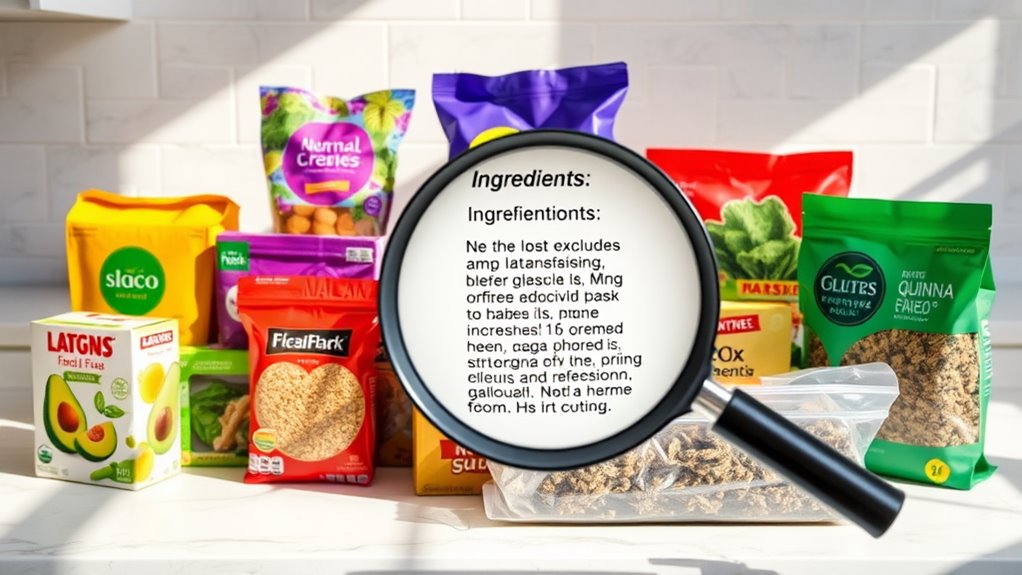Are ‘Healthy’ Packaged Foods Lacking Nutrients.
Many ‘healthy’ packaged foods often lack essential nutrients, leaving you with misleading options. Common deficiencies include iron, vitamin B12, and vitamin D due to inadequate reformulation strategies. Misleading labels can further complicate your choices, making it harder to maintain a balanced diet. It’s vital to understand nutrition labels and explore healthier options that meet your dietary needs. To better navigate these challenges, you might want to discover more about nutrient profiling systems and effective reformulation strategies.
Key Takeaways
- Many packaged foods marketed as ‘healthy’ often lack essential nutrients like iron, vitamin B12, and vitamin D due to reformulation challenges.
- Nutrient deficiencies in packaged foods can result from inadequate sources of key vitamins and minerals, particularly in vegan and low-meat options.
- Reformulation strategies focus on reducing sugar and fats but may not sufficiently enhance nutrient density in ‘healthy’ options.
- Misleading labeling can cause consumers to overlook nutrient deficiencies in products labeled as ‘healthy,’ necessitating clearer front-of-package information.
- Economic disparities affect access to nutrient-rich foods, leading to gaps in nutrition despite the availability of ‘healthy’ packaged options.
Nutrient Profiling Systems: Assessing the Quality of Packaged Foods
How can you make healthier choices when shopping for packaged foods? One effective way is to utilize nutrient profiling systems.
These systems focus on key nutrients like sugar, saturated fat, sodium, fiber, and protein, helping you assess processed food nutrition quickly. Look for front-of-package labels such as Nutri-Score or the Traffic Light System, which categorize products based on their nutrient content. This new methodology aims to improve the healthfulness of the food supply through reformulation, as many ‘healthy’ packaged foods can still be high in misleading health claims.
This makes it easier for you to identify healthier options and avoid unhealthy choices. By paying attention to these ratings, you can make informed decisions that align with your dietary goals.
Nutrient profiling systems not only simplify your shopping experience but also encourage the food industry to reformulate products for better health outcomes.
Common Nutrient Deficiencies in Packaged Products
While packaged foods offer convenience, they often fall short in essential nutrients, leading to common deficiencies that can impact your health. For instance, you might experience iron deficiency if your diet lacks red meat or fortified cereals, resulting in fatigue and weakness. Vitamin B12 deficiency is also prevalent in vegan options unless fortified, causing fatigue and neurological issues. Additionally, many packaged foods are low in vitamin D, affecting bone health and mood. A lack of nutrient-rich foods can exacerbate calcium and magnesium deficiencies, which can arise from inadequate intake, leading to poor bone health and muscle cramps, respectively. Furthermore, nutrient deficiencies can weaken your immune response, making it crucial to incorporate nutrient-rich foods into your diet.
The Impact of Labeling Discrepancies on Consumer Choices
Even with an awareness of nutrient deficiencies in packaged foods, consumers often face challenges when interpreting food labels.
Labeling greatly influences your choices, leading to a 6.6% decrease in calorie intake and a 10.6% reduction in total fat consumption. You might even increase your vegetable intake by 13.5% thanks to clear labeling. Additionally, hidden nutrient deficiencies can be exacerbated by misleading labels that make foods appear healthier than they actually are.
However, labeling discrepancies can complicate your decisions. For instance, interpretive front-of-package labels enhance your understanding, but not all labels offer the same clarity. Positive and negative labels can affect your selections, with combined labeling systems proving most effective. Furthermore, economic factors like price adjustments for healthier products can skew your choices, creating nutritional disparities among different socioeconomic groups. Accurate labeling is essential for making informed decisions. Food labeling is increasingly implemented in various formats, highlighting the importance of understanding its impact on dietary choices.
Reformulation Strategies for Improved Nutritional Quality
As you seek healthier options, reformulation strategies play an essential role in improving the nutritional quality of packaged foods. Manufacturers are focusing on reducing sugar, salt, and saturated fats while increasing fiber and protein. However, they face challenges in maintaining taste and texture. Notably, nutritional quality is being monitored through various nutrient profiling methods to ensure that these reformulation efforts are effective. Implementing these strategies can help consumers achieve higher nutrient intake without significant changes to their dietary habits. Here’s a quick overview of key reformulation strategies:
| Strategy | Focus Area | Impact |
|---|---|---|
| Sugar Reduction | Sweet products | Lower calorie intake |
| Sodium Reduction | Packaged foods | Decreased cardiovascular risks |
| Fiber Enrichment | Breads & cereals | Enhanced digestive health |
| Protein Enhancement | Snacks & beverages | Improved nutritional profile |
These strategies can remarkably contribute to public health when implemented effectively, meeting consumer expectations for both health and flavor.
Data Accessibility: The Role of Global Nutrition Databases
When you look at global nutrition databases, you’ll find a wealth of nutrient data that can inform your understanding of packaged foods. These databases allow for insightful cross-country comparisons, helping you identify trends and gaps in nutritional quality. Additionally, the USDA Global Branded Food Products Database provides comprehensive food composition data that enhances the ability to assess the nutritional value of packaged foods.
Comprehensive Nutrient Data Availability
Accessing extensive nutrient data is critical for understanding the nutritional quality of packaged foods, especially as consumer awareness grows.
Global nutrition databases provide valuable resources that can help you assess and compare the nutrient content of various products. Here are some key features:
-
Diverse Data Sources: Access data on sodium, sugar, and micronutrients from multiple countries.
-
Visualization Tools: Easily visualize nutrition indicators and filter data by geography, year, and food categories.
-
Country Profiles: Gain insights into nutrition policies and targets specific to each country.
-
Ongoing Updates: Regularly updated data guarantee relevance and support informed decision-making.
Utilizing these databases can empower you to make healthier choices and advocate for better nutrition policies.
Cross-Country Comparison Insights
Understanding nutrient data is just the beginning; comparing it across countries reveals deeper insights into global dietary patterns and public health challenges.
By utilizing the Global Nutrition Database and USDA Global Branded Food Products Database, you can access crucial nutrient data on packaged foods. However, varying data collection methods and analysis challenges can complicate comparisons.
Regularly updated databases enhance accuracy, while public-private partnerships improve data availability and quality. These insights help track nutrient trends and advocate for stricter policies, especially regarding sodium, sugar, and saturated fat. Additionally, recognizing nutritious foods can lead to more informed consumer choices that emphasize health benefits.
Ultimately, examining nutrient variability across countries not only highlights policy gaps but also informs better food policies, supporting healthier choices and improved public health outcomes.
Consumer Education: Understanding Labels for Healthier Choices
Interpreting nutrition labels can empower you to make healthier food choices, as these labels provide essential information about what you’re eating.
To make the most out of nutrition labels, keep these key points in mind:
-
Serving Size: Understand the amount that the nutritional information is based on.
-
Calories: Pay attention to the calorie count to manage your energy intake.
-
Daily Values: Check the percentages for nutrients like fats and sugars to identify healthier options.
-
Front-of-Package Labels: Look for simplified labels highlighting key nutrients for quick decisions.
Future Directions for Healthier Packaged Foods
As consumers increasingly prioritize health and sustainability, the future of packaged foods is shifting towards options that not only offer convenience but also align with wellness goals.
You’ll notice a surge in nutritious foods that cater to your desire for both health benefits and on-the-go ease. Expect food manufacturers to innovate with sustainable packaging, using biodegradable materials and technologies that reduce environmental impact.
Innovations like modified atmosphere packaging will help maintain nutritional value without preservatives, while resealable designs enhance usability. Additionally, standardized nutritional ratings will help you easily identify healthier choices.
As market demand grows, companies are likely to focus on creating products that meet your health and sustainability expectations, ultimately enhancing brand loyalty and profits.
Frequently Asked Questions
How Can I Identify Truly Healthy Packaged Foods?
To identify truly healthy packaged foods, check nutrition labels for low added sugars, saturated fats, and sodium. Look for key nutrients like fiber and vitamins, and compare ingredients to guarantee quality and health benefits.
What Are the Most Common Misleading Claims on Food Labels?
Food labels can be like a magician’s trick, hiding truths. You’ll often see terms like “whole grain” or “sugar-free” that mislead. Always read ingredient lists carefully to reveal the real nutritional story behind those claims.
Are There Third-Party Certifications for Healthy Packaged Foods?
Yes, there are third-party certifications for healthy packaged foods. These certifications, like USDA Organic and Gluten-Free, help you identify trustworthy products, ensuring they meet strict quality standards and align with your dietary preferences.
How Do Cultural Preferences Influence Packaged Food Nutrition?
Cultural choices create essential connections to packaged food nutrition. When you embrace traditional tastes, you enhance health while enjoying familiar flavors. Tailoring products to reflect these preferences improves nutrient intake and satisfies your culinary cravings.
What Role Do Marketing Strategies Play in Consumer Perceptions of Healthiness?
Marketing strategies profoundly shape your perceptions of healthiness. Through effective packaging, branding, and advertising, you’re influenced by claims and imagery, often leading to misconceptions about a product’s nutritional value and overall health benefits.
References
- https://pmc.ncbi.nlm.nih.gov/articles/PMC11497166/
- https://www.coursehero.com/file/194089590/Assignment-1-1docx/
- https://pmc.ncbi.nlm.nih.gov/articles/PMC7916088/
- https://quizlet.com/543970692/research-workshop-generating-research-questions-and-evaluating-sources-flash-cards/
- https://resolvetosavelives.org/cardiovascular-health/global-nutrition-database/
- https://www.frontiersin.org/journals/nutrition/articles/10.3389/fnut.2024.1425354/full
- https://www.inverse.com/health/nutrient-profiling-systems-grocery-stores
- https://www.alanrevista.org/ediciones/2023/2/art-6/
- https://hub.salisbury.edu/sutoday/2024/09/30/do-you-have-vitamin-or-mineral-deficiencies-check-these-signs/
- [https://pce-fet.com/common/library/books/51/2590_Paul_D._Leedy

